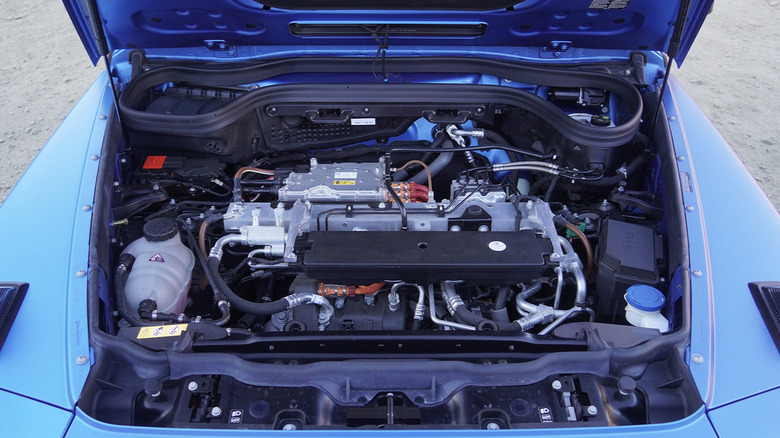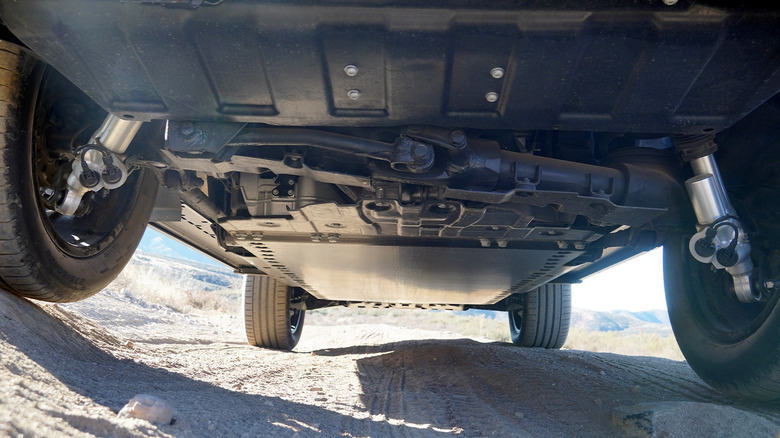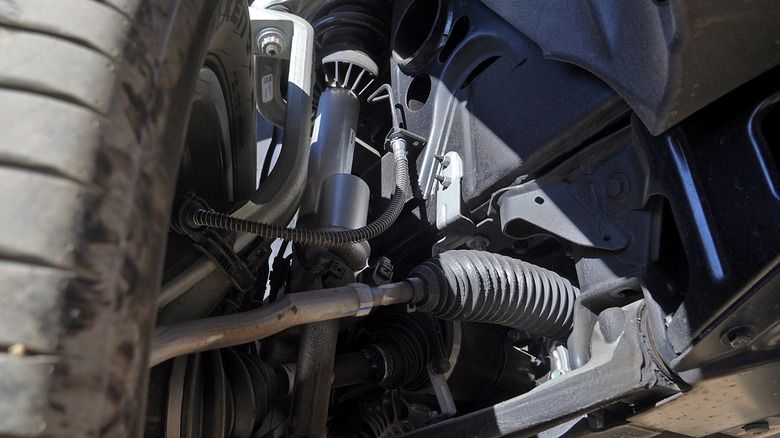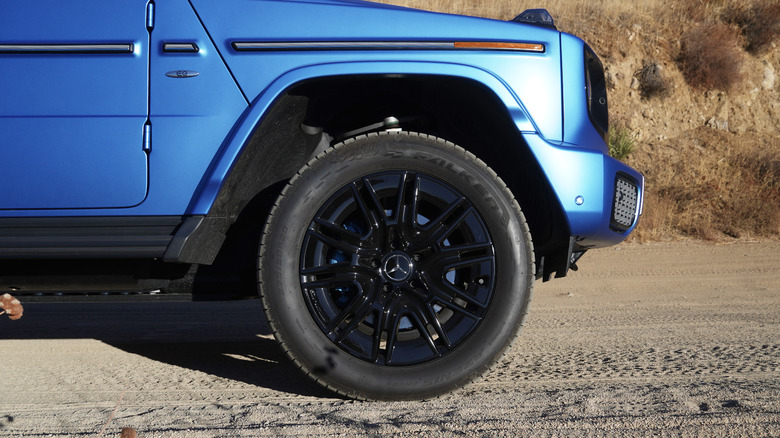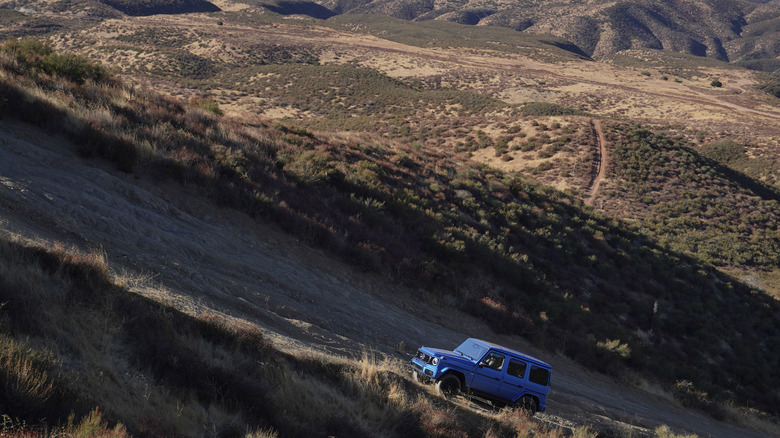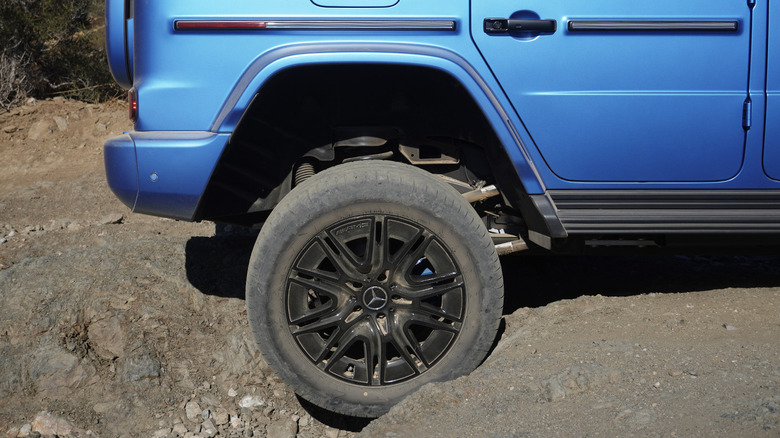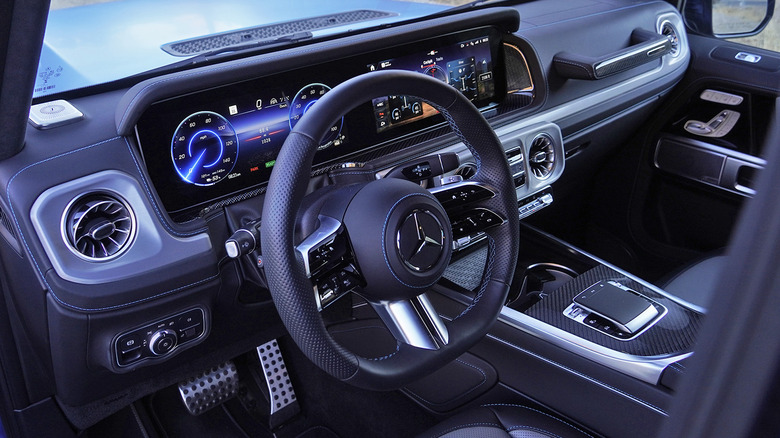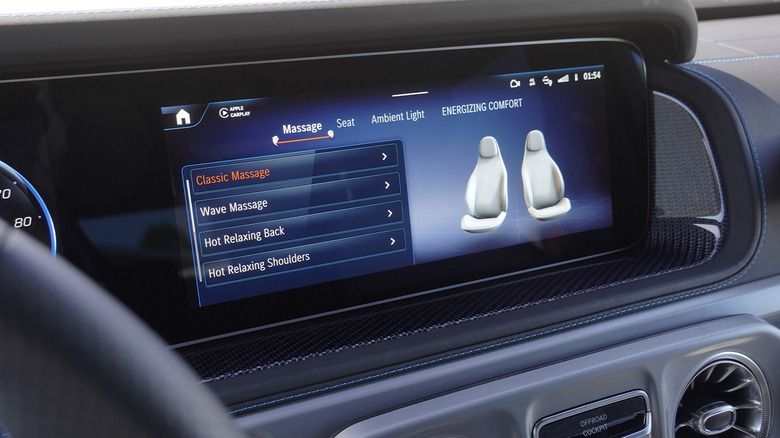2025 Mercedes-Benz G 580 Review: Electric Makes This The Best G-Wagen Yet
- The best G-Wagen of all time
- Unbelievable off-road capability
- Can rip through traffic like a beast
- Still cramped and upright inside
- Minimal range due to body-on-frame engineering
- Suspension struggles to cope with weight at times
As more and more G-Wagens began to proliferate around the streets of Los Angeles over the past two decades, secret doubts began to crop up in my mind about the true spirit of such big, boxy SUVs. And yet, as the years passed, I also started to harbor secret dreams of building out an early-2000s G with big knobby tires and triple-locked solid axles. The naturally-aspirated V8 powering a simple and capable truck, that adds at least a little bit of that functional Benz luxury to the tried-and-true Jeep Wrangler recipe, and creating a beefy off-roader that ends up at least somewhat more livable.
Then I drove a modern G-Wagen with independent front suspension, a barking twin-turbo AMG V8, and those egregious electronically adjusting seat bolsters that swell up while cornering. The sense of claustrophobia I felt behind the wheel only emphasized the terrible ergonomics and packaging of a former military vehicle turned undeniable status symbol, which still lacked a touchscreen and used a trackpad for infotainment instead. Why, oh why, would the Kardashians ever think this was a good idea?
The answer to question never asked
So, when Mercedes-Benz inevitably announced the electric G earlier this year, my cogitations reached a new level of confusion. Romping ratings of 579 horsepower and 859 lb-ft of electric torque sounded solid, albeit silent. That kind of quiet only enhances the luxury experience, and we know that so much low-end grunt delivered with naught more than a whisper also transforms the off-roading experience entirely. All without detracting in any way from the instantaneously identifiable styling. Hmmm...
The real question in my mind emerged as I attempted to comprehend how 'Benz integrated four electric motors and a massive 122-kilowatt-hour battery pack into the G's existing body-on-frame chassis. What a challenge 'Benz set out to solve, even if the eventual engineering success essentially answered a question that nobody ever asked.
Revisiting the de Dion tube
The solution: de Dion rear suspension, which originally debuted on steam-powered tricycles. As far as I know, the newest car I've driven with a de Dion tube between the rear wheels? Yep, you guessed it, a 1986 Alfa Romeo GTV6. But here's the fun part, since the specific GTV6 I drove was the "Alpine Alfa" built for Aether Apparel by the Bridan brothers and Bo Scarbo—just Google it, but suffice to say that experience left me very curious to drive a stock GTV6, too.
Mercedes used the de Dion setup because squeezing two electric motors into a live axle apparently presented too much of a challenge. Remember we gave up on the G's solid front axle, in favor of independent suspension to improve daily driving dynamics, back in 2019. So the new electric G-Wagen's front end proved easy enough: Just swap two electric motors into the space where the engine, transfer case, and front differential went, with an axle leading to each wheel.
What's in a name?
Imagine that first R&D meeting, though, when some brilliant engineer presented the ingenious idea to try out a de Dion tube to transform the new project's rear setup. Uproar, perhaps, then some serious consideration. After that Alfa, you just don't see many de Dion tubes these days—other than on a Mitsubishi Fuso, which I'd love to drive, but that's whole 'nother story.
So eventually, whatever we want to call the electric G-Wagen, or the EV G, or the E-GQ, or the G-EV, but instead rather the G 580 with EQ Technology, finally arrived. Equipped with quad motors, de Dion rear suspension, and a so-called "Design Box" bolted on the barn door tailgate, none of the options for official nomenclature looked good, yet Benz undoubtedly went with the worst one, hinting at a backpedaling on electrification following recent market trends. As I scoured the press releases, though, market trends looked less likely to affect the electric G than pricing, which can easily climb to $192,000 (as tested) and effectively rules out the riff-raff.
Suspension coping with serious weight
The number-one symptom of the electric G-Wagen's inexplicable math stopped calculating properly in my mind the very first time I drove this loaner, on a quick trip to Trader Joe's. About half the time on that classic nine-block Agoura Hills commuting adventure, a strange shudder showed up in the suspension and steering. I felt the vibration in the seat of my pants, too, to the point that my suspicions built up so strongly that when I arrived home, before even throwing the groceries in the fridge, I pulled out a tire gauge to test the pressures all around. Sure enough, my gauge showed 38 PSI for the fronts and 46 for the rears. So what gives? Other than the lifespan of my cabbage...
I suspect the answer lies in that gosh-darn-genius de Dion suspension, or at least so I hope. Because the staccato wheel hop points to difficulties ironing out all the details originally dictated by the decision to shoehorn an EV into the world's most legitimately military-derived vehicle currently available to the general public—other than a Tesla-swapped Hummer I drove recently, which actually works surprisingly well.
An off-road sojourn, in the name of science
Essentially, that big 122 kWh battery pack, the four motors, and the de Dion rear end—all housed within or bolted onto the original body-on-frame chassis—contribute to the electric G's mass totaling up to a whopping 6,801 pounds. That GTV6, you ask? More like under 2,800 pounds (don't ask about a steam-powered trike). I truly tried to comprehend what I felt, or whether I needed to consciously counter my confirmation bias in action, but the shudder seemed to stem from the rear tires chopping over rougher roads. And even some smooth surfaces, actually.
Then again, I long ago learned that anything I might notice in a day, or a week, or months of testing, professional automotive engineers already know all about. So why, oh why, would 'Benz actually bring such a setup to fruition? To answer my own frustrated questions, I took the electric G off-roading. And on my usual testing lap up the big climb at Rowher Flats—with the usual caveats of "all things considered"—the electric G truly put on the greatest display of off-roading capability of any vehicle I've ever driven.
Aired all the way up
The single detail most critical to making such a wild claim stems from another peculiar decision, namely that Mercedes plans to sell all 2025 model years officially as "First Edition" G-Wagens. That spec includes 20-inch wheels with a design that doesn't allow my Viair compressor's nozzle to reach the valve stem, a lesson I learned recently after off-roading a Ranger Raptor at Rowher, when I needed to drive home on the highway still deflated to 22-24 PSI. In this case, the wheel design leans more toward sheer style points than the Ranger Raptor's faux beadlockers—oh wait, that's even more posturing, Ford.
The Ranger Raptor came equipped with BFGoodrich K03 tires, though, and as more befitting for a city-slicker EV, the electric G-Wagen wore slippery Falken all-seasons. Again, the doubts started to creep in, but I figured that by taking the run as easy as possible, I might just drive up the hill and turn around when the going got too tough.
Testing these tires in tight turns
First, I tried out the "G Steering," a simple trail turn system similar to the Ford Bronco's Trail Turn Assist that brakes the inside wheel while sending power to the outside wheel. On the G, Benz's programming can spin each electric motor individually to produce the same effect, or even in reverse to do the so-called "tank turn" feature (officially known as "G Turn"). The G Steering worked well, cranking me around a fencepole and down into a short grade toward a dried-up creek.
But did it actually work well? I started to wonder, as I heard the left rear tire skittering over rocks and rubble. Sure, the turning radius tightened up, but dragging a tire on a 7,000-pound rig over potentially sharp edges presented a bit of a foreboding feeling for the climb ahead. Oh, the negativity coursing through my veins, and in fairness, I planned to avoid the rockiest segments ahead that looked ripest for shearing tire treads. Instead, I wanted to take the YouTuber line only where possible, to demonstrate articulation and traction in the name of science.
What's in the box?
See, out on the trail solo—always a bad idea—the electric G compounds on any potential pucker factor by not providing the option to swap on a spare in the case of a flat tire. That silly cargo case holds a plastic charger instead, and unlike other EVs that use a skateboard battery layout to maximize interior volume, the electric G packs everything into the ladder frame and leaves little room elsewhere for storing a full-size spare.
Aired up, with me and my gear contributing at least another 199 pounds to creep past the seven grand mark, I barely expected to get up Rowher's steep and cambered gatekeeper. And then the G just climbed right up, without a single solitary millisecond of wheel slip—and I would have noticed, too, because the coolest part of off-roading EVs is the easily perceptible level of aural traction not covered up by internal-combustion engine noises.
Low range in a torquey EV makes a little less sense
Alrighty then! The positivity once again started to flood my synapses. Or, I should say, some optimism began tamping down my nerves about the tires, because these slippery Falkens kicked off the climb doing far better than expected. I selected 4-Low via the Off-Road Cockpit switchgear, to test 'Benz's claims that each electric motor uses true gear reductions rather than reducing throttle response, and thereby smoothing out torque delivery. This G 580 lacks the portal axles of a 4×4², after all.
Higher and higher we climbed, the G constantly and consistently exceeding expectations. I began to appreciate that narrow hood, such a contrast versus other enormous pickups and SUVs on the market today. The subtle smoothness of electric torque, the ability to one-pedal drive thanks to adjustable regen, and far, far, far more articulation than anticipated. So much so that I struggled to stop with a tire up in the air for photos. Oh, well.
Squashing all the doubts
Then we reached a point where just a week previous, I almost turned around in that Ranger Raptor: a steep, off-camber elephant track where I needed all three diffs locked, every last bit of my courage and skill, and luck to get over. And remember, even with the BFG K03s–the best in the biz–aired down and scrabbling for grip as the nose raised up and up and then slammed down as the rears spun and contorted unhappily in the dry dirt.
The 'Benz just giggled at the same obstacle on a different day. Turns out, discrete traction control programming that takes advantage of four electric motors makes a huge, and I can't say this hugely enough, a UUUGE difference. Cross-axled, city tires fully inflated, the de Dion rear suspension coping with over 7,000 pounds of boxy mass, I only caught maybe six to eight inches of tire slippage. I can list so many reasons why this should not have worked, and yet the electric G transformed such a formerly challenging obstacle into a ho-hum nothingst.
Hard charging back on asphalt
Of course, we're a long way from the kind of desert-ripping, dune-charging, whoop-jumping fun that Raptor suspension float can deliver to the trophy truck and SxS-obsessed masses. But at the very least, I got a solid taste of what Mercedes-Benz's engineers no doubt debated while developing the electric G. That guy de Dion for the win, to say the least, despite the fully inflated tires.
Skimming down Bouquet Canyon Road along the backside of Rowher flats, those Falkens started to complain more. Similar to blasting around in quintessential Raptor form, at high speeds on the tarmac, the gig starts to fall apart. Even with the shock dampers stiffened up and the steering tightened in Sport mode, something's gotta give. And by that I mean the limits of sanity, when tire traction teeters on the edge of full-on oversteer, pulled back from the brink once more by the discrete traction vectoring of quad-motor electric propulsion.
Max regen for max range
But in comparison, this level of performance winds up entirely beyond the pale of any internal-combustion G-Wagen, even the top-spec AMG packages. Ripping through traffic with a deadline in mind, a gas G simply sucks, lugging the engine that only sounds happy at high revs, transmission tuned to at least achieve some meager semblance of two-digit fuel economy.
And the electric G's real-world range proved surprisingly legit, despite those minimalist attempts to improve upon the aerodynamics of a brick. The slow-speed off-roading no doubt helped despite the steep ascent, but I also kept the regenerative braking at max recuperation via the paddle shifters, and Benz's software shows an expected number, plus an ideal "Max" figure that signifies the potential remaining range under perfect circumstances—aka no air-conditioning, flat roads at low speeds, a gale-force tailwind maybe.
Gas G shortcomings carry over
Absolutely not, I'm in a G-Wagen so electric or otherwise, I simply refuse to sacrifice comfort or convenience. Then again, I needed to swing through Topanga on the way from Rowher to LAX, and at one point in the day, my range remaining dropped well below the mileage still to go. Running late for a flight, I lacked the spare time to stop and charge for even 10 minutes—then again, I lacked the time to run out of electrons and call a tow truck, too. But after regen-ing down Topanga Canyon Boulevard to the Pacific Coast Highway, then over to the 10 freeway and down Lincoln Boulevard, this Californian made it to LAX with 27 miles remaining.
Of course, my refusal to budge on comfort and convenience only means so much, given the electric G-Wagen's obvious shortcomings that carry over from its internal-combustion predecessors. Any consideration for ergonomics goes right out the window, for both the front and back seats that ride too high and lack legroom, not to mention the physical proximity of screens in front of my face. The cargo capacity lacks volume, too, other than in the vertical dimension, and the hilarious trackpad on the center console eliminates more room for storing personal items despite switching the infotainment over to a touchscreen.
2025 Mercedes-Benz G 580 Verdict
After a week ripping around Los Angeles, then off-roading with a level of capability I never imagined possible, I started to ponder the prospect of a properly differentiated electric G in depth. Imagine a similar exterior shape, but ditch the ladder frame in favor of a legit skateboard to maximize interior volume. Despite my earlier doubts, keep the de Dion suspension, add a frunk(!), and lower the center of gravity to only further enhance both the on and off-roading capability.
After all, with no box-frame steel, the weight can probably drop a fair amount more, too. Add in mildly improved aero, both visible and via underbody ground effects, to help improve the range beyond a 239 mile rating. Lose the tasteless "G Roar" sound experience and the mandatory blue carbon-fiber weave of the First Edition package. Now that would be the best G-Wagen ever!
And yet, even as built with such dubious initial parameters, I can unequivocally declare that the G 580 with EQ Technology is the best G-Wagen ever, inescapable flaws and all. Silly, senseless, and spectacular, spinning like a top with the G steering tank turn, Benz should perhaps have called it the Calabasas Edition instead. Presumably, a long list of pre-orders means Mercedes can't build them fast enough. Even if I will keep on inescapably daydreaming about one day building a naturally aspirated, V8-powered, solid-front axle G 500, which will inevitably do just about everything worse than the new electric G.


